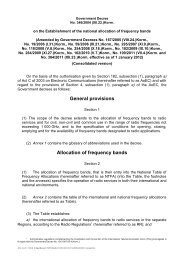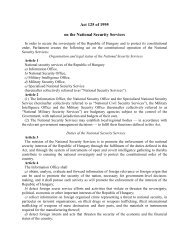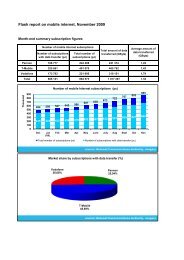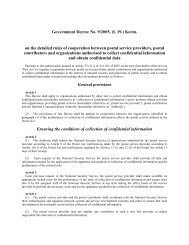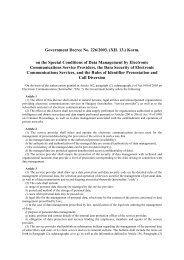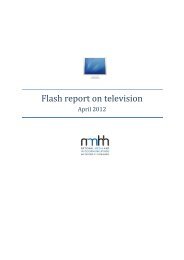The Hungarian Communications Market Developments and ...
The Hungarian Communications Market Developments and ...
The Hungarian Communications Market Developments and ...
Create successful ePaper yourself
Turn your PDF publications into a flip-book with our unique Google optimized e-Paper software.
20 21<br />
sional knowledge but also for the development of new measuring<br />
equipment.<br />
International role of the Measurement Service<br />
<strong>The</strong> professional requirements, methodology <strong>and</strong> procedures of<br />
measurement are internationally harmonized, thus the Measurement<br />
Service, being a major partner of several national <strong>and</strong> international<br />
organisations, has extensive international relations.<br />
2.5 Identifier management<br />
<strong>The</strong> identifiers required for the provision of communications services,<br />
the operation of communications networks <strong>and</strong> the interoperability<br />
thereof are a state property. In accordance with Eht., the Government<br />
defines the basic principles <strong>and</strong> conditions of identifier management;<br />
whilst NHH is in charge of the management of identifiers, including the<br />
assignment <strong>and</strong> reservation thereof, the modification <strong>and</strong> withdrawal<br />
of licenses, keeping records of such activities, <strong>and</strong> the publication of<br />
any related information as laid down by legal regulations.<br />
Regular Authority duties<br />
<strong>The</strong> number of procedures related to the authorization of identifiers<br />
has been fairly constant since 2004, with a continuous increase in<br />
revenues from the fees for the use of identifiers. <strong>The</strong> National Plan<br />
for the Allocation of Identifiers (ANFT) is reviewed once in every<br />
three years, as laid down in Eht. Based upon the review in 2005, the<br />
Authority presented a proposal for the fundamental revision of the<br />
government decree on ANFT <strong>and</strong> identifier management <strong>and</strong> of the<br />
ministerial decree on the fee for the reservation <strong>and</strong> use of identifiers.<br />
As a result of the review, in 2008 the Authority recommended<br />
modifications in response to the changes in communications markets<br />
to facilitate the entry of new service providers to the market.<br />
Key Authority projects<br />
Identifier Management Database<br />
In 2005, in accordance with the provisions of legal regulations, the<br />
Authority established an Identifier Management Database to support<br />
identifier management through keeping relevant records, which also<br />
functions (on the website of NHH) as an online information supply<br />
service to customers.<br />
Number portability<br />
Number portability, i.e. the right of subscribers to retain their<br />
numbers when switching service providers, is an essential means<br />
of boosting market competition. <strong>The</strong> implementation of number portability<br />
was laid down in Directive 2002/22/EC, effective in Hungary<br />
as of the date of the country’s accession to the EU. National regulations<br />
defined the introduction of number portability as a multi-step<br />
procedure: as of 1 January 2004 the portability of geographical<br />
numbers used in fixed-location telephone networks <strong>and</strong> as of 1 May<br />
2004 that of mobile numbers <strong>and</strong> numbers for services with special<br />
rates (toll-free, split charge, premium rate) became possible under<br />
EU provisions. In 2007, the previous government decree on the rules<br />
of number portability was modified in accordance with the Authority’s<br />
recommendations. As a result, the number portability procedure<br />
has become faster, with nomadic (or location-independent) numbers<br />
also falling under portability rules as of 1 January 2008.<br />
In cooperation with service providers, NHH has been playing a<br />
crucial role in the technical implementation of number portability,<br />
in preparing the pertaining legislation, <strong>and</strong> in the establishment <strong>and</strong><br />
continuous operation of the Central Reference Database required for<br />
implementation.<br />
Central Reference Database (KRA)<br />
<strong>The</strong> Central Reference Database is an element of the technical implementation<br />
of number portability, which contains <strong>and</strong> h<strong>and</strong>les routing<br />
information of all ported numbers <strong>and</strong> service provider information as<br />
laid down by law. Established by NHH in accordance with legal regulations,<br />
KRA started operating on 1 January 2004, on the date of the<br />
introduction of number portability. 2006 developments also extended<br />
to the interconnection of the number portability Central Reference<br />
Database <strong>and</strong> the Identifier Management Database, which enables the<br />
control of number portability reports. In 2007, after consultations with<br />
service providers, KRA functions were improved <strong>and</strong> extended based<br />
upon the modification of number portability rules.<br />
Preparation for the new numbering system<br />
<strong>The</strong> appearance of a multitude of new technological solutions<br />
<strong>and</strong> services as well as the convergence of telecommunications,<br />
informatics, <strong>and</strong> media inevitably call for a review of the Regulatory<br />
Strategy as regards identifiers <strong>and</strong> for fundamental changes in the<br />
currently applied numbering system. <strong>The</strong>refore, in 2008, after carrying<br />
out comprehensive analyses, the Authority developed a strategy<br />
for setting up <strong>and</strong> introducing a long-term numbering system.<br />
International activities<br />
<strong>The</strong> Authority also participates in the work of several international<br />
organisations in connection with identifier management on a regular<br />
basis, including ITU (ITU-T SG2), the European <strong>Communications</strong><br />
Committee (ECC WG NNA) <strong>and</strong> the St<strong>and</strong>ardisation Institute (ETSI<br />
TISPAN WG4). <strong>The</strong> Authority’s contribution is directed towards the<br />
elaboration of European recommendations <strong>and</strong> reports as well as<br />
the transposition of international regulations.<br />
<strong>The</strong> transposition of Decision 2007/116/EC on the use of the<br />
national numbering range beginning with 116 was a key event of<br />
the period between 2004 <strong>and</strong> 2008. Hungary was one of the first<br />
countries in Europe to introduce numbers 116000 (hotline for missing<br />
children) <strong>and</strong> 116111 (child helpline).




